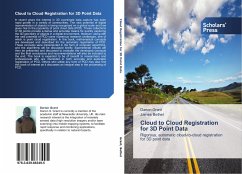In recent years the interest in 3D coordinate data capture has seen rapid growth in a variety of communities. The vast potential of digital representation of objects is being recognized on a global scale and has given rise to the popularity of point cloud data (PCD). These collections of 3D points provide a dense and accurate means for quickly capturing the 3D geometry of objects in a digital environment. However, along with the vast potential of PCD come numerous research challenges, one of which is point cloud registration. In this book, mathematical concepts are developed and described for the automatic registration of PCD. These concepts were implemented in the form of computer algorithms, and the algorithms will be discussed briefly. Experimental results will then be presented and discussed to evaluate the developed concepts and the final conclusions and recommendations will also be included to the end. The book is expected to be of benefit to researchers and professionals who are interested in both accurate and automatic registration of PCD. Others who utilize any form of PCD may also find this book of interest as it discusses an integral step in the processing of PCD.
Bitte wählen Sie Ihr Anliegen aus.
Rechnungen
Retourenschein anfordern
Bestellstatus
Storno








